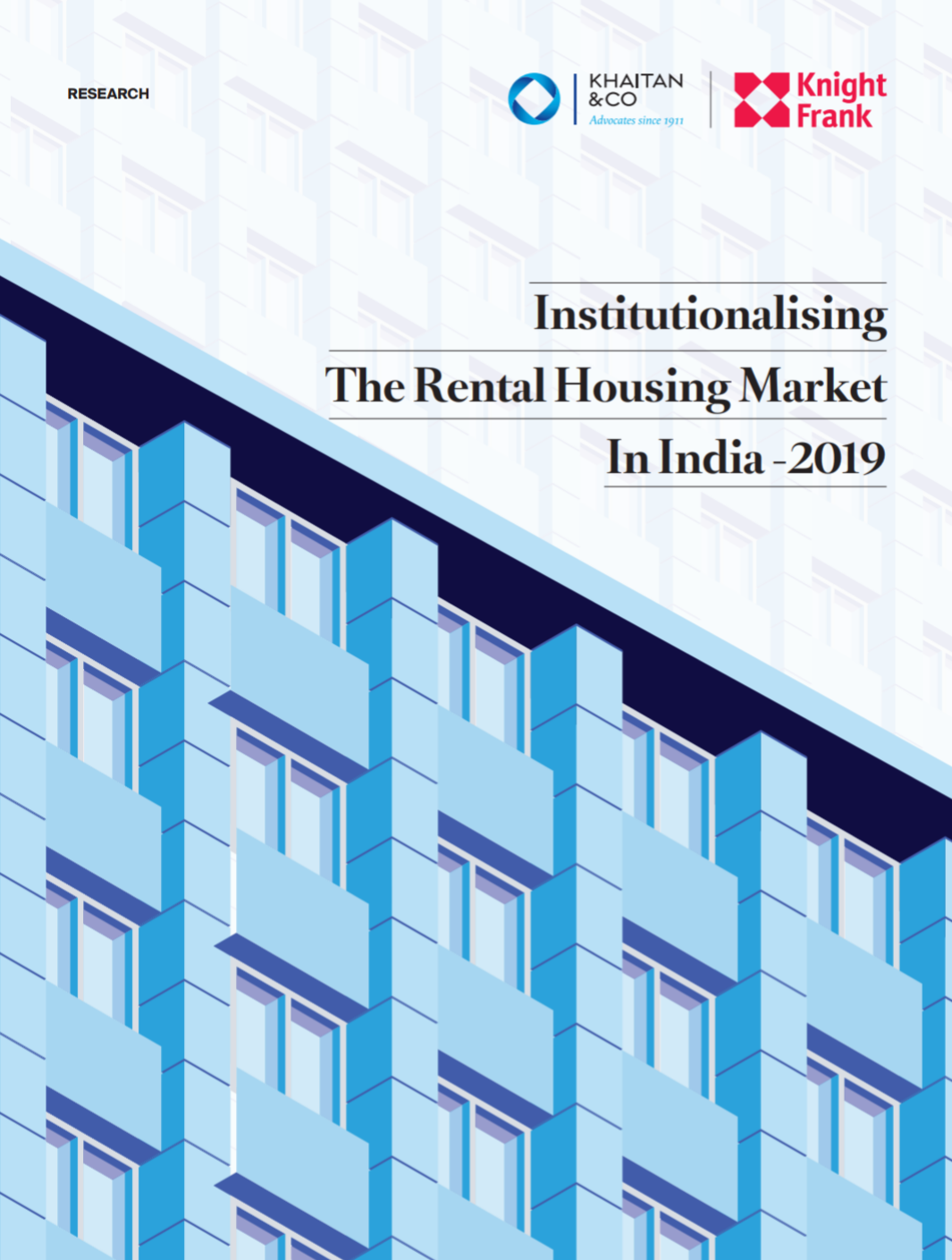
 Upcoming Model Tenancy Act set stage for institutionalising the country’s rental housing market
Upcoming Model Tenancy Act set stage for institutionalising the country’s rental housing market
MUMBAI, OCTOBER 14, 2019 (GPN) : Knight Frank India , an international property consultancy and Khaitan& Co, one of India’s largest law firms, released an in–depth study “Institutionalising the Rental Housing Market in India – 2019” which analyses the Draft Model Tenancy Act, 2019 (MTA).India has nearly 11.09 million urban vacant housing units of which 10 states and Union Territories (UTs) contribute to 78% (8.64 million) of total vacancy levels. The report estimates that the MTA will be instrumental in institutionalising rental housing, which is largely unorganised in India. If rental housing is institutionalised with the introduction of a legal framework as envisaged, it would help in creating large purpose-built rental stock which can also attract institutional investments in the long run.
The Draft Model Tenancy Act, 2019 proposes to create a legal framework to bring harmony to the landlord–tenant relationships and balance the scale for both parties. However, there are several areas from the perspective of both the parties where the Act provides no or limited clarity which can create challenges in its implementation. This Act aims to bring stakeholders together and bring rental housing reforms to create an effective rental housing ecosystem in the country. Currently, there are 21.72million urban rented households in India. Tamil Nadu (16.5%), Andhra Pradesh (13.8%), Maharashtra (13.5%), Karnataka (11.3%), Gujarat (6.1%), West Bengal (5.9%), Uttar Pradesh (5.1%) and the National Capital Territory (NCT) of Delhi (4.3%) together command a substantial 76.5% of total urban rented households.
The report advocates that the Draft Model Tenancy Act, 2019 when implemented will ensure the growth of institutional rental housing in India, especially in its megapolises and metropolises.
Shishir Baijal, Chairman and Managing Director of Knight Frank India said “As we move towards a more flexible work environment globally, there is need for the Indian real estate sector too to envisage itself as a service, rather than a product. The addition of over 223 million new urban residents to the cities by 2031 will not be feasible if the rental housing market is not developed. However, in order to truly institutionalise and revive the rental market more thought and debate is required to evolve the Model Tenancy Act into a meaningful, holistic and comprehensive piece of legislation.”
Sudip Mullick, Partner of Khaitan& Co said “Limited policy relating to rental housing and existing legislations unfriendly to landlords / owners of premise have been a big deterrent for creation of rental housing stock in the country. The MTA provides a much-needed independent mechanism specially engineered to deal with issues pertaining to rental premises. MTA will provide for speedy remedies to both owner and occupier of rental properties and will enable the court to deal with more legal factors which require evaluation of various issues arising out of changing environment of complex commercial transactions, government policies and new laws.”
KEY FINDINGS FROM THE STUDY:
Current Rental Housing Scenario in India
- As per Census 2011, there are a total of 27.37 million rented households in India, of which 79.4% (21.72 million)are urban rented households.
- Nearly half of 21.72 million urban rented households are occupied by 3 or 4 member nuclear families. The fact that 50% of typical nuclear families in urban households live with a rented roof over their head dispels the myth of home ownership being a priority in an average Indian family’s scheme of things.
Total number of urban rented households in India by household size
| Household size (by number of family members) | Number of Urban Rented Households | % of total |
| 1 | 1,114,522 | 6% |
| 2 | 2,705,861 | 12% |
| 3 | 4,418,157 | 20% |
| 4 | 6,535,280 | 30% |
| 5 | 3,582,344 | 16% |
| 6 to 8 | 2,913,034 | 13% |
| 9+ | 454,525 | 3% |
| Total | 21,723,723 | 100% |
Source: Knight Frank Research, Census 2011
- Of 21.72 million rented households in urban India, the following 8 states and Union Territories comprise the highest percentage share of rented households in India. These 8 regions alone comprise 16.63 million or 76.57% of the total urban rented households. Tamil Naduwith 16.5% has the highest percentage share of rented households in India followed by Andhra Pradesh and Maharashtra.
| State or UT name | Number of rented households | % share of region in the total rented households in India |
| Tamil Nadu | 3,590,179 | 16.5% |
| Andhra Pradesh | 3,004,702 | 13.8% |
| Maharashtra | 2,940,731 | 13.5% |
| Karnataka | 2,447,718 | 11.3% |
| Gujarat | 1,315,157 | 6.1% |
| West Bengal | 1,292,263 | 5.9% |
| Uttar Pradesh | 1,114,832 | 5.1% |
| NCT of Delhi | 929,112 | 4.3ource: Knight Frank Research, Census 2011 |
- As per the Census 2011, 11.09 million houses remain vacant in urban areas despite the massive housing shortage due to various factors such as low rental yield, poor maintenance of vacant stock, fear of repossession, dilapidated state of buildings and lack of incentives. As an extension of these market realities, the potential of converting urban land into investment and providing a steady source of income to landlords remains nil.
~ end ~
About Knight Frank
Knight Frank LLP is the leading independent global property consultancy. Headquartered in London, Knight Frank has more than 19,000experts operating from over 512 offices across 60 markets. The Group advises clients ranging from individual owners and buyers to major developers, investors and corporate tenants. For further information about the Company, please visit www.knightfrank.com.
In India, Knight Frank is headquartered in Mumbai and has more than 1,400 experts across Bangalore, Delhi, Pune, Hyderabad, Chennai, Kolkata and Ahmedabad.Backed by strong research and analytics, our experts offer a comprehensive range of real estate services across advisory, valuation and consulting, transactions (residential, commercial, retail, hospitality, land & capitals), facilities management and project management. For more information, visit www.knightfrank.co.in
About Khaitan & Co
Founded in 1911, Khaitan & Co is one of the oldest and largest Indian law firms. Combining a rich heritage of over a hundred years with a modern and cutting-edge practice, the Firm offers full service legal solutions to our domestic and international clients. The Firm’s endeavour has been to be proactive and exceed client expectations. We take pride in our approach to work that focuses on understanding clients’ business and anticipating their legal needs (present and future) and provide pragmatic and commercial solutions.
The Firm has increasingly invested in the state-of-the-art infrastructure facilities across all its offices. We constantly strive to evolve and adopt international best practices to serve our clients better. The emphasis is to ensure our clients have access to a consistently high quality of service across all its locations and practice areas.
Khaitan & Co’s clients include business and financial enterprises, banks, financial institutions, private equity funds, government bodies, educational and charitable trusts, cultural institutions, high net worth individuals, and estates and trusts from India and overseas.


Be the first to comment on "11.09 million vacant houses in India; high potential for institutional rental housing: Knight Frank India and Khaitan& Co Report"